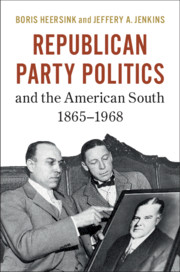Book contents
- Republican Party Politics and the American South, 1865–1968
- Republican Party Politics and the American South, 1865–1968
- Copyright page
- Contents
- Tables
- Figures
- Preface
- 1 Introduction
- 2 The Republican Party and the South: Some Preliminaries
- Part I The South and National Republican Party Politics, 1865–1968
- 3 The Rise and Fall of a Republican South, 1865–1877
- 4 The Attempt to Rebuild the Republican Party in the South, 1877–1896
- 5 The System of 1896 and Republicanism in the South, 1897–1932
- 6 Toward a Modern Southern Strategy, 1933–1968
- Photos
- Part II Southern Republican Party Politics at the State Level
- Index
5 - The System of 1896 and Republicanism in the South, 1897–1932
from Part I - The South and National Republican Party Politics, 1865–1968
Published online by Cambridge University Press: 06 March 2020
- Republican Party Politics and the American South, 1865–1968
- Republican Party Politics and the American South, 1865–1968
- Copyright page
- Contents
- Tables
- Figures
- Preface
- 1 Introduction
- 2 The Republican Party and the South: Some Preliminaries
- Part I The South and National Republican Party Politics, 1865–1968
- 3 The Rise and Fall of a Republican South, 1865–1877
- 4 The Attempt to Rebuild the Republican Party in the South, 1877–1896
- 5 The System of 1896 and Republicanism in the South, 1897–1932
- 6 Toward a Modern Southern Strategy, 1933–1968
- Photos
- Part II Southern Republican Party Politics at the State Level
- Index
Summary
The presidential elections of 1896 and 1900 established the GOP as the majority party across most of the United States for the better part of the next three decades. But while the Republicans expanded their dominance in the Northeast, Midwest, and West, the South remained almost exclusively Democratic throughout this period. As a result, the traditional argument that a GOP revival in the "Solid South" remained a possibility – which, in part, validated the sizable Southern presence at Republican National Conventions – rang increasingly hollow. That is, Republican leaders mostly concluded that the cost of maintaining a party organization in the South that was fit to compete electorally with an implacable Democratic majority outweighed the increasingly slim chances at GOP electoral success there. Republican administrations continued to use their control of patronage in the South to produce a reliable and sizable voting bloc that played a significant role in the selection of presidential candidates in 1908 and 1912. At the same time, however, several moves were made by competing factions to reduce the size of the Southern delegations. Not all of these moves were entirely genuine; rather, some were threats to (successfully) force compliance on other issues. Additionally, Republican leaders were far from consistent in their support of Southern delegates and were prone to changing their positions depending on whether they were the ones who controlled federal patronage. Thus, as the GOP moved into a position of national political domination, its Southern political organizations increasingly became pawns in a game of national-level party politics.
- Type
- Chapter
- Information
- Republican Party Politics and the American South, 1865–1968 , pp. 133 - 162Publisher: Cambridge University PressPrint publication year: 2020

